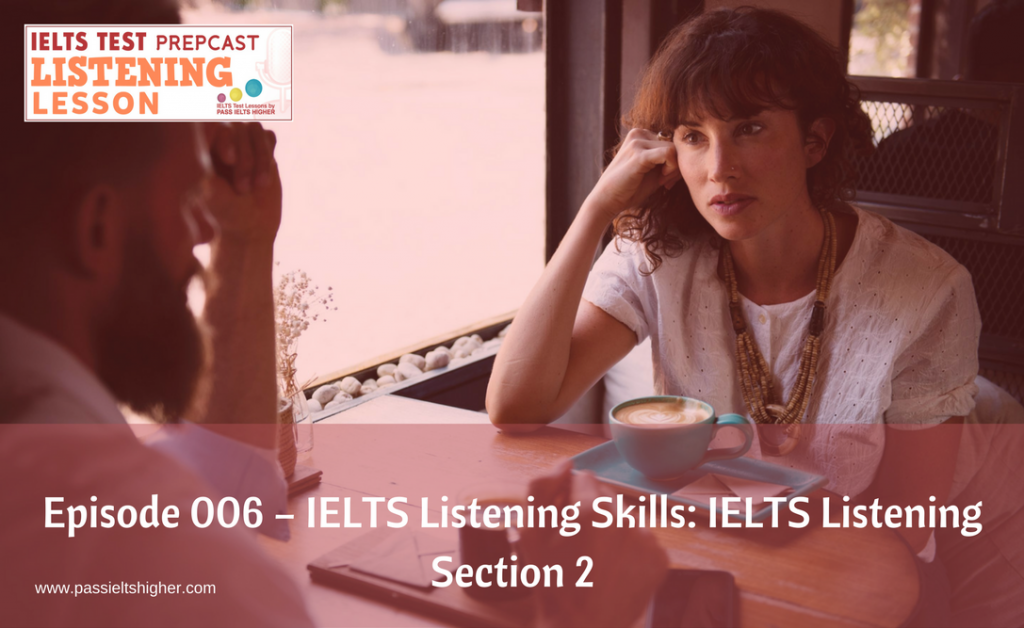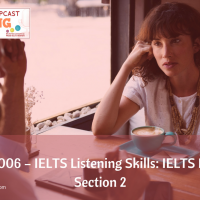

- Social:
- Link:
Today we’re talking about IELTS listening section 2 and Andrea will be describing the section 2 part of the IELTS listening test.
Click here to be taken to iTunes where you can subscribe to all of the IELTS Test Prepcasts.
If you enjoy this free IELTS Test Prepcast, please show us your support and appreciation by clicking here. This will shoot you over to iTunes, where you can leave a rating and review.
If you would like to know how to leave an iTunes Review – Click Here
Podcast Transcription
IELTS Test Prepcast Episode 6
IELTS Listening Skills: IELTS Listening Section 2
The IELTS Test Prepcast provides three free IELTS test lessons each week for candidates who are aiming for IELTS band scores 7, 8, or 9.
I’m Steve Price. I’m the founder of the Pass IELTS Higher website, which was started in late 2010 and has been successfully helping students achieve higher band scores since.
Andrea Price currently lives and works in London, teaching IELTS, and has previously lived in Spain. She is a qualified teacher of English as a second language and has been teaching the subject at home and abroad for over twenty years.
If you enjoy this free IELTS Test Prepcast, please show us your support and appreciation by heading over to ieltstestPrepcast.com and clicking the “subscribe on iTunes” button at the top of the page. This will shoot you over to iTunes, where you can leave a rating and review.
And now for today’s IELTS lesson . . .
Steve: Hello. Today we’re going to be talking about IELTS listening section 2. I have with me today Andrea, and she’s going to be describing the section 2 part of the IELTS listening test.
Andrea: Hello. In IELTS listening section 2, you’ll hear somebody talking or giving a talk about an activity or an interest, and the situation is nonacademic. The reason to point this out is because of the language; the language is a little bit less formal than following sections. In the content, you’ll hear somebody describing a picture or a diagram that you have to label; that’s one possibility. Or it could be a guided tour around a country house, and while you’re listening, you need to note where certain places are on a map. These activities require some specific skills, as well as the ones already mentioned for section 1, which is key words and synonyms, could be names, etc., etc., numbers. Okay.
Steve: Can I just ask a quick question there. The accent of the people on the tape, could they be any of the accents that you’d expect from the English-speaking countries?
Andrea: Yes, in any of the listenings, any of the accents are possible. Typical ones are Australian, Canadian, American, New Zealand, and British ones, Scottish, Irish, sometimes Welsh, local dialects, northern, things like that, yes.
Steve: Okay.
Andrea: So it could be any accent. Okay. In section 2, your skills are focused on three areas. Skill number 1 is descriptions. The speakers will often include descriptions of shape. For example, what adjectives can you use to describe the shape of a lake in a state in your home, because they might be describing a map and telling you how to find a lake, and they’ll say that it’s circular or maybe round. Or they might tell you to go along the path around the lake. How would they describe that? They might say “the inner part of the area” or “the outer part of the section.” Another thing they could describe is an object, so you might be looking at a statue, maybe. And so they might talk about metallic, wooden, sharp, or striped. The second skill you need to know is place and prepositions to do with place. The place of position of what’s being described may be very important. This could be for labeling because they’ll be telling you “At the top of the object, you’ll see something,” and you have to note down what you can see. Or they might say, “At the top of the map, you can see the country home” or “the café,” and so they’re using expressions like “at the top,” “underneath,” “inside,” “opposite.” Because it’s a map, or in other areas, they might use the points of the compass, so they’ll be talking about the north end, the south end, the south to the southwest, then do you know the opposite? So the southeast, the northwest, the northeast. And the third thing that they’ll focus on is directions. Obviously, because it’s a map, you’re going to need to understand directions. In the listening section, you’re also expected to be able to follow directions. In order to arrive at the place that you are being directed to, which you will later have to name and then put on the list with a letter. You then have to say the place you’re at. This usually has a letter. You then have to link the letter to a place from a list of places that you’ve been given. Remember the instructions. If you’re asked to put a letter, put the letter. If you put the name of the place, even if the answer’s correct, you will lose marks because you haven’t followed instructions. So also think about unusual directions that you may not be used to, such as “just beyond this” or “beside the lake” or “it runs parallel to.” And finally, there’s some advice for the listening exam. When you are labeling a diagram or completing a table, make sure you know where the numbers for each question are. In a table, do the numbers go across or down? In a diagram, is number 1 at the top with number 2 at the bottom and number 3 to the left-hand side? The answers to the questions will be given in order, but the place where you need to write the answer may not be in numerical or sequential order. If you haven’t found where the numbers are, you’ll lose valuable time and then actually miss the answers to the questions. Remember to follow the instructions as well. If you are asked for three words and you put four, your answer will be marked wrong because you didn’t follow the instructions. If you’re asked “Put the letter given for your choice of answer” but again you put the answer, even if your answer is right, it will be marked wrong because you didn’t follow the instructions. I’ll give you a couple of examples of how this happened or why this is serious. In my class one day, one of my students said, “Oh, that’s what I’ve been doing! I was easily losing five points by not putting the letter.” So by not following the instructions, five points in the IELTS exam is at least a whole band score. And guess what? She has now achieved the 7 she wasn’t getting, because she’s following instructions.
Steve: Okay. You mentioned in your advice that if they ask for three words, then you’ve got to give three, not four. Are there any exceptions to that at all? Or are there any tips that you could use? Say, for example, the answer that you believe is correct has got four words, and maybe it’s including the words “an” or “on” or “in” or something like that, is there some advice for that?
Andrea: There is, and that’s a good question. Thank you for reminding me to point it out. You will never be asked for more than three words. Sometimes only one, sometimes two. If you have four words and you think everything is correct, what you should do is, or what you can do is remove the articles, so words like “the” and “a.” And adjectives also are usually not important. So if you remove those, you’ll have enough words to put in the gap. I would only just ask you to be careful if you need to say that there is one of something. If you do, then “a” is necessary, but adjectives you can remove.
Steve: So thanks for your explanation of section 2 there. Would there be a similar approach for section 3?
Andrea: Not really. As the sections go along, they get harder, and section 3 and section 4 is where the students have to be good to get their higher bands from 7 and upwards. It gets harder because the conversations are between more people, so in section 3, the conversations are between up to about four people, and the situations are more academic. The conversations might be between students and students, or students and their tutors, and usually they’ve done some sort of project or a type of assignment and they’re discussing it. You have to listen carefully to all the voices here because what happens is that they would have similar voices expressing different opinions, or you need to understand the English that will show you that there’s another person speaking. So you might have two speakers who’ve got opposing ideas, and then a third person comes into the conversation, and that person might agree with either of those speakers or have their own opinion.
Steve: Could I just ask, when we’re talking about multiple people speaking, do they have more than one accent in there?
Andrea: Yes.
Steve: So is there a Scottish person and an English person, for example?
Andrea: Yes, always you’ve always got to be aware that you might be listening to different accents. You might hear an English person speaking to an Australian, so yes, you’ve always got to be prepared for different kinds of accents.
Steve: Okay.
Andrea: Right. If another person comes along, there are expressions that introduce these people, so you have to listen out for those expressions. So you would’ve been listening to an expression between two people, and then one of those two people might say something like “And what do you think, Anna?” And then Anna comes in with a completely different opinion or agrees with one of them, and so that you know, because they use similar voices, you know that there’s a third person in the conversation. The questions in sections 3 and 4 are progressively harder to answer and—
Steve: Sorry, before you go on to that, so you mentioned that there are phrases that you can listen out for. Are there any names for those? Is there a generic name . . .
Andrea: No, collocations. They’ll be collocations, really.
Steve: So these are things that you would expect to hear, and intuitively, you would expect that someone else . . .
Andrea: Yes, you know that someone else is coming along. So I might say something like “And what do you think?” so you know that introduces someone else. Or I might say, “Oh, he’s right, you know,” so you know that someone else has spoken.
Steve: Okay.
Andrea: So yes, and because it’s not obvious, those are things you have to listen out for. So the question in sections 3 and 4 are progressively harder to answer, and usually but not always are the sections where if you answer well, you can achieve your higher band scores. I say that because section 3 and section 4 are intended to be harder, but sometimes my students say, “Oh, section 2 was really difficult,” so I’m just generalizing that these are where you get your better band scores. As usual, it relies on your knowledge of key words and synonyms. These always allow you to answer the questions correctly for your higher band scores. In the listening exam, you’re given time to read the questions. You go in the question booklet and you’ve got to read the questions. You underline the key words, then when the person starts speaking to you, you have to listen for similar expressions that will allow you to answer the questions. Again, there are plenty of examiner tricks, so you must beware. These questions are often multiple choice, and one technique for the multiple choice is to see which questions it isn’t the answer to. You can work backwards, really. So you listen, you look at the questions, you look at what you’re given to use for an answer, and you can realize that you were not right, so the other one must be right. If you’re having difficulty, it’s probably easier to answer backwards.
Steve: Okay. Is it a bit like the sort of multiple choices that I would’ve done at school, where you have maybe four answers, one was completely barking and nothing at all to do with the question, and of the others, one was obviously the right answer and two are very similar?
Andrea: Yes, it’s a mix of those, really. There’s a couple that are really wrong, but if your English is not good, they might sound right because something is similar. Well, there’s one that’s obviously wrong because it’s not included, so yes, I agree. And then there’s one that’s definitely right, if you know the key words and synonyms.
Steve: Okay.
Andrea: Yes, so that’s right. That’s a good point. Another kind of question you might be asked is to match something from a list, and you’ve got to match that, the one you choose to a description. This again relies on your knowledge of key words and synonyms, so always, always you’re seeing how important this knowledge of key words and synonyms is. Another skill which is essential here is to understand what you call signpost words. These signpost or highlight the fact that an answer is coming and that the answer is usually opposite to what was usually expressed.
Steve: Sorry, can you just rehearse for me what a signpost word was? I guess what we could do is we can put something in the show notes just so the people can go and look at that and read it and understand it. Is it a big topic? Is it something we could perhaps have a whole other lesson at some point?
Andrea: For sure.
Steve: Okay.
Andrea: For sure, there are loads of words, and you have to know what they mean, and once you know what they mean, then the answers become much easier, because this is how an examiner makes a trick. So the examiner or the people will be speaking, and you’re going to think that’s the right answer, then all of a sudden, a signpost word will come, and a signpost word can be something like “although,” “but,” “unlike.” And so you might say, “His birthday was on the third of September but,” and the minute you hear that, you know that the real answer is coming, so the signpost words just highlight that fact.
Steve: Okay.
Andrea: And there are plenty of them, so I agree that you could do a lesson.
Steve: Okay, yes, we’ll plan that one in. Okay, well, I think from previous discussions we’ve had, the final section of listening is a bit longer to talk about now, so we’ll create a separate lesson for that. So we’ve dealt here today with section 2 and also section 3, and we’ve got a few pointers for ourselves to make some other lessons to explain some of the elements that came out, like signpost words and some of those things. So I think for today we’ll wrap up, and we’ll see each other again next time.
Andrea: Thank you.
Steve: Okay, bye-bye.
Andrea: Bye-bye.
End of Lesson
You’ve been listening to the IELTS Test Prepcast, which provides free IELTS lessons for candidates aiming for IELTS band scores 7, 8, or 9. Subscribe to this Prepcast in iTunes, or download it from our website, www.ieltstestprepcast.com.

Leave a Reply